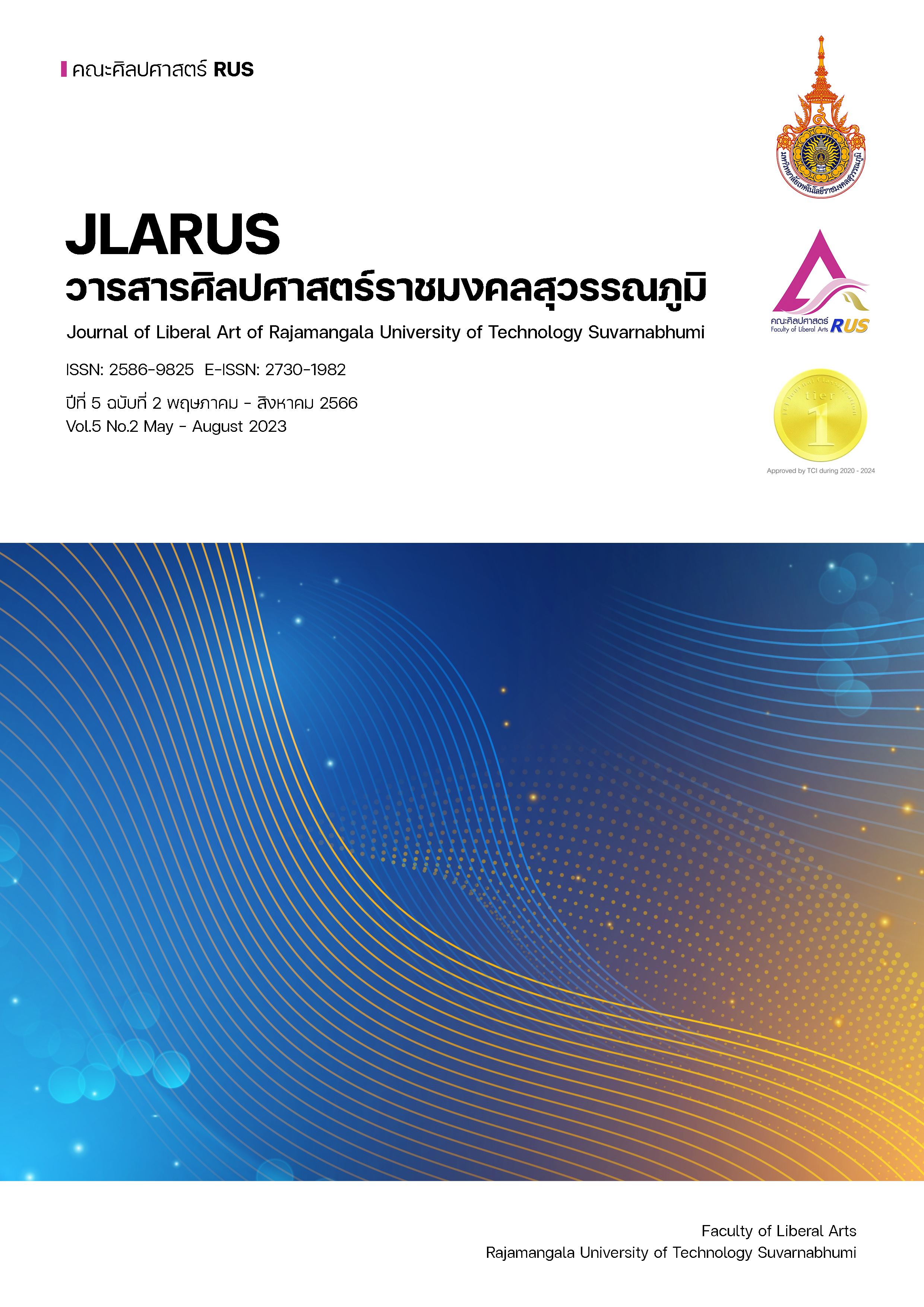INFLUENCE OF LEADER AND MEMBER EXCHANGE ON WORKPLACE FUN THROUGH THE PSYCHOLOGICAL SAFETY MEDIATOR OF FULFILMENT SERVICE WAREHOUSE EMPLOYEES IN SAMUT PRAKAN PROVINCE
Main Article Content
Abstract
The topic of leadership effectiveness remains in the organization and can direct the organizational performance. With the innovative economy, it has become more important to enhance the development of effective teams to meet customer satisfaction. While the team feels fun (no pressure/ dispute, a good climate) at work by employing psychological safety mediator, it can be defined as one’s openness and involvement in the job to see the influence of Leader-member exchange on Workplace fun. This study attempted to investigate the influence of Leader-Member Exchange (LMX) on Workplace Fun mediating Psychological Safety. The study used a sample selection of 250 full-time employees in Fulfilment Service Warehouse, Samut Prakan province, Thailand. Data were collected by online questionnaires measuring those constructs with good reliability and validity confirming with Confirmatory Factor Analysis (CFA) or the covariance-based structural equation model (CB-SEM) and Confirmatory Composite Analysis (CCA) or the partial least square structural equation model (PLS-SEM). The findings revealed a positive association between LMX and Workplace Fun and confirmed the assumptions on the moderating role of Psychological Safety having a high correlation with Workplace Fun. It fully mediated the relationship between CFA and CCA. The results pointed out the importance of considering the interplay of both the LMX and Psychological Safety to increase employees’ Workplace Fun, enhance their work performance and easily manage employees’ perspectives on the element of workplace culture.
Article Details

This work is licensed under a Creative Commons Attribution-NonCommercial-NoDerivatives 4.0 International License.
References
Aldag, R. and Sherony, K. (2001). A spoonful of sugar: some thoughts on “fun at work”. Current Issues in Management, 1(1), 62-76. Retrieved on September 25,
from http://www.emeraldinsight.com/0959-6119.htm.
Agatz, N. A., Fleischmann, M. and Van Nunen, J. A. (2008). E-fulfillment and multi-channel distribution–A review. European journal of operational research, 187(2), 339-356.
Bolton, S. C. and Houlihan, M. (2009). Are we having fun yet? A consideration of workplace fun and engagement. Employee Relations, 31(6), 556-568.
Baldonado, A. M. (2015). Workplace fun: Learning from Google, Southwest Airlines and
Facebook. International Journal of Research in Business Studies and Management, 2(12), 15-18.
Bilginoğlu, E. and Yozgat, U. (2020). Workplace fun: a management tool for employee
engagement.? İş ve İnsan Dergisi, 7(1), 13-22. The Journal of Human and Wok. Volume-Issue: 7.
Breukelen Van W., Schyns B., Blanc. P Le. (2006). Leader-member exchange theory and
research:Accomplishments and future challenges. AGE Publications (London, Thousand Oaks, CA and New Delhi) Vol 2(3): 295–316.
Collinson. DL. (2002). Managing Humour. Journal of management studies, 2002 - Wiley
Online Library. https://onlinelibrary.wiley.com/doi/abs/10.1111/14676486.00292.
Dansereau Jr, F., Graen, G. and Haga, W. J. (1975). A vertical dyad linkage approach to
leadership within formal organizations: A longitudinal investigation of the role
making process. Organizational behavior and human performance, 13(1), 46-
Retrieved June 25, 2022. https://www.researchgate.net/profile/George.
Dijkstra, T. K. and Henseler, J. (2015). Consistent and asymptotically normal PLS
estimators for linear structural equations. Computational statistics and data analysis, 81, 10-23.
Edmondson, A. C., Roberto, M. A. and Watkins, M. D. (2003). A dynamic model of top
management team effectiveness: Managing unstructured task streams. The
Leadership Quarterly, 14(3), 297-325.
Electronic Transaction Development Agency: ETDA. (2021). Value of e-Commerce Survey 2021.https://www.etda.or.th/th/pr-news/Value-of-e-Commerce-2021-Press-Con.aspx.
Erdogan, B., Bauer, T. N. and Walter, J. (2015). Deeds that help and words that hurt: Helping and gossip as moderators of the relationship between leader–member exchange and advice network centrality. Personnel Psychology, 68(1), 185-214.
R. Fluegge-Woolf, E. (2014). Play hard, work hard: Fun at work and job performance. Management Research Review, 37(8), 682-705.
Ford, R. C., McLaughlin, F. S. and Newstrom, J. W. (2003). Questions and Answers about Fun at Work. Human Resource Planning, 26(4).
Fluegge, E. R. (2008). Who put the fun in functional? Fun at work and its effects on job
performance. University of Florida.
Graen, G., Cashman, J. F., Ginsburg, S. and Schiemann, W. (1977). Effects of linking-pin quality on the quality of working life of lower participants. Administrative Science Quarterly, 491-504.
Hair Jr, J. F., Howard, M. C. and Nitzl, C. (2020). Assessing measurement model quality in PLS-SEM using confirmatory composite analysis. Journal of Business Research, 109, 101-110.
Hemsath.D, L Yerkes. (1997). 301 ways to have fun at work. Published by Berrett-Koehler Publishers. https://www.scribd.com/book/134856347/301-Ways-to-Have-Fun-At-Work?utm_medium.
INABA, K., HOCHI, Y., IWAASA, T. and MIZUNO, M. (2021). Relationships between the
psychological safety, job resources and work engagement of fitness club
employees. Juntendo Medical Journal, 67(4), 360-366.
Jhantasana, C. (2022).Using Latent Variables for Confirmator Composite Analysis.
Creative Business and Sustainability Journal, 44(2), 22-40.
Kawa, A. and Zdrenka, W. (2016). The conception of integrator in cross-border e-
commerce. LogForum, 12(1), 63-73.
Liden, R. C. and Maslyn, J. M. (1998). Multidimensionality of leader-member exchange:
An empirical assessment through scale development. Journal of Management, 24(1), 43-72.
Officer of the National Economic and Social Development Council. (2017). Retrieved July 4, 2022.https://www.nesdc.go.th/nesdb_en/main.php?filename=index.
Putsom, W. and Junbua, J. (2020). The causal factor of leader-member exchange, in role job performance and innovative job performance that affect job satisfaction of employees. Rajabhat Chiang Mai Research Journal, 21(3), 174-192.
Qin, X., Liu, Z. and Tian, L. (2020). The strategic analysis of logistics service sharing in an e-commerce platform. Omega, 92, 102153.
Twes., et al., (2014). The Fundamental role of workplace fun in applicant attraction. Journal of Leadership and Organizational Studies, 19(1), 105-114. http://jlo.sagepub.com/content/19/1/105.
Schriesheim, C. A., Neider, L. L. and Scandura, T. A. (1998). Delegation and leader-member exchange: Main effects, moderators and measurement issues. Academy of Management journal, 41(3), 298-318.
Zeng, H., Zhao, L. and Zhao, Y. (2020). Inclusive leadership and taking-charge behavior: roles of psychological safety and thriving at work. Frontiers in Psychology, 11(62), 1-11


